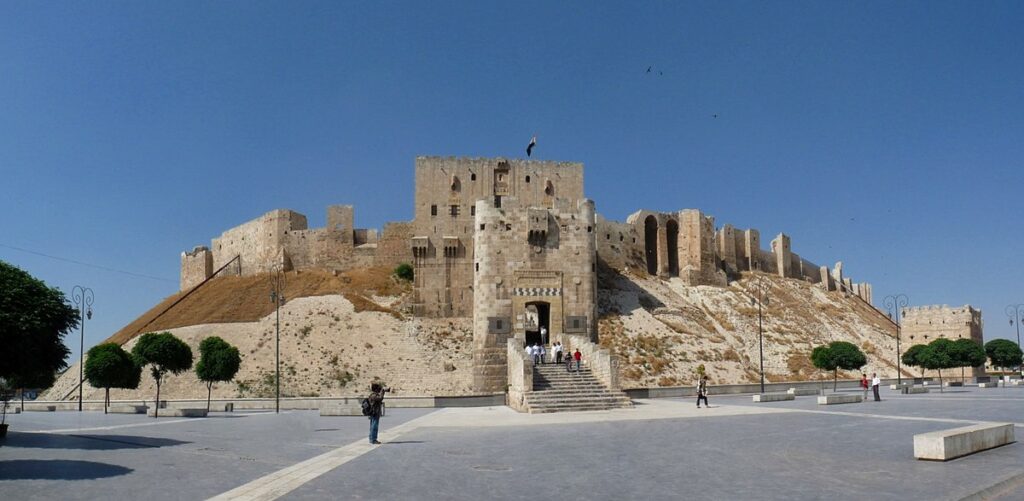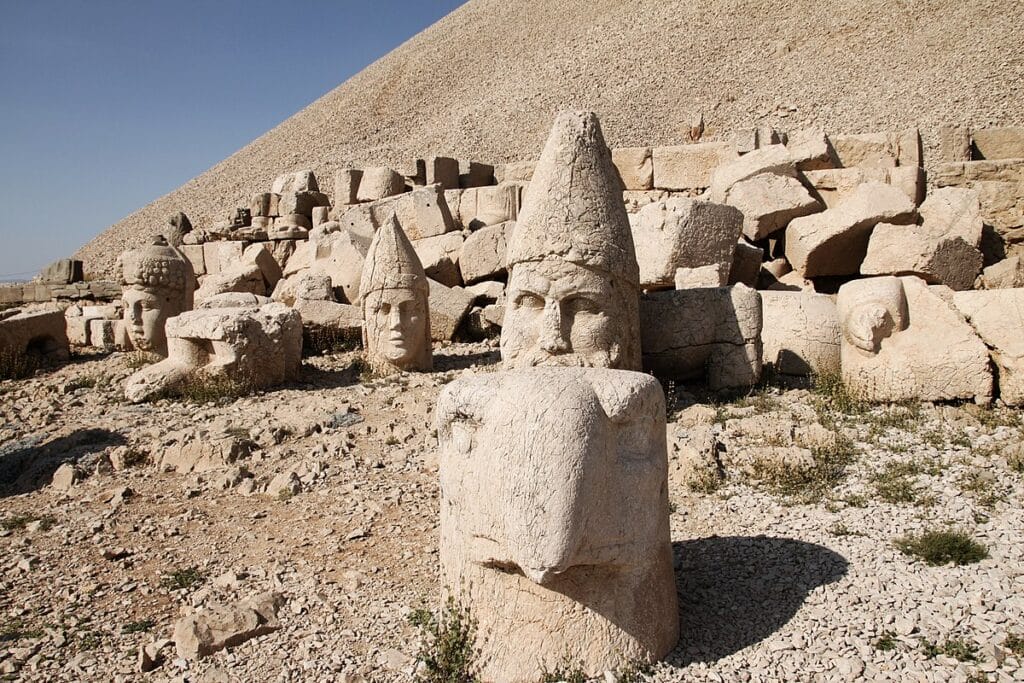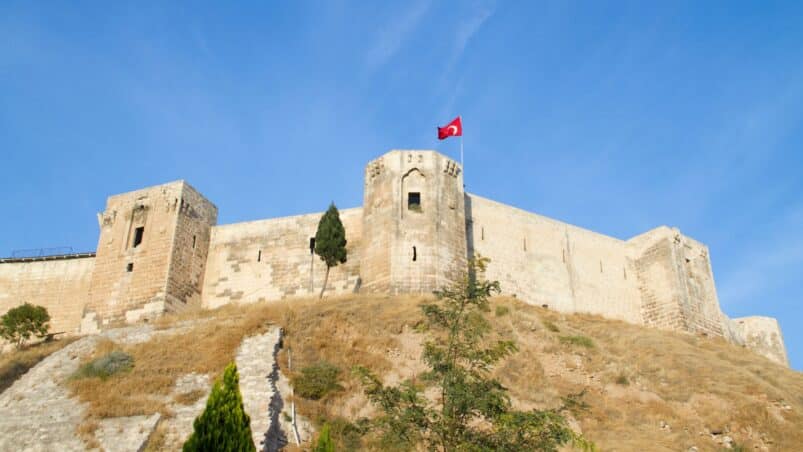Multiple cultural heritage sites were damaged during the major earthquake which struck central Turkey and northwest Syria Monday 6 February. The devastating earthquake of magnitude 7.8 – killing more than 2300 people and injuring thousands – heavily damaged the Syrian Citadel of Aleppo and the Turkish Gaziantep Castle. As the first one was listed in 1986 as a World Heritage Site, the latter was included on UNESCO’s tentative list.
This article is updated when EHT receives news on the situation of cultural heritage sites in Turkey and Syria. Updates below: Update 6 February 15:00 CET: Gaziantep news Update 7 February 10:30 CET: Details on Aleppo Update 7 February 16:00 CET: UNESCO statement Update 8 February 14:30 CET: Details on New Mosque in Malatya Update 9 February 13:30 CET: Translated statement Turkish Ministry of Culture and Tourism
The 2200-year-old castle in Gaziantep – a large city in the westernmost part of Turkey’s Southeastern Anatolia Region – collapsed during the earthquake. “Some of the bastions in the east, south and southeast parts of the historical Gaziantep Castle in the central Şahinbey district were destroyed by the earthquake, the debris was scattered on the road,” CNN translated a report from the Turkish state-run news agency Anadolu.
“The iron railings around the castle were scattered on the surrounding sidewalks. The retaining wall next to the castle also collapsed. In some bastions, large cracks were observed”, the report continues.
The castle was built by the Hittite Empire as an observation point on top of a hill at the centre of Gaziantep. It was later built into a main castle by the Roman Empire in the 2nd and 3rd centuries AD. It underwent further expansion and renovation under Emperor Justinian I, in the 6th century.
Nowadays, the castle is used as the Gaziantep Defence and Heroism Panoramic Museum, and a documentary regarding the defence of the city against the French forces after the fall of the Ottoman Empire runs periodically. Gaziantep is listed as a tentative UNESCO World Heritage site, meaning it was given funds for renovation to bring it up to the standards required by UNESCO.
Syrian UNESCO site damaged
The Citadel of Aleppo, an official UNESCO World Heritage Site, was damaged as well, a source from the Directorate-General of Antiquities of Syria said. “We have received reports of a crack in the Citadel of Aleppo and sent a team of specialists to inspect the site and assess the damage”, stated Houmam Saad, a senior official at the directorate.

The large medieval fortified palace in the centre of the old city of Aleppo is considered to be one of the oldest and largest castles in the world. It was listed as World Heritage Site in 1986. Usage of the Citadel hill dates back at least to the middle of the 3rd millennium BC. The majority of the construction as it stands today is thought to originate from the Ayyubid period (late 11th century). The Citadel underwent extensive conservation work after suffering damage during the Syrian Civil War in 2012.
UPDATE 6 FEBRUARY 15:00 CET
A local Turkish news agency, Daily Sabah, reported that more heritage sites in Gaziantep have been damaged as well. The eastern wall and dome of the historical Şirvani Mosque have partially collapsed. The mosque, one of the oldest in the city as it was built in the 17th century, is near the Gaziantep Castle.
And in the southern city of Iskenderun, the Cathedral of the Annunciation has almost completely collapsed, the Daily Sabah reported as well. The Catholic church was originally built between 1858 and 1871 by the Order of the Carmelites and then reconstructed in 1901 following a fire.
UPDATE 7 FEBRUARY 10:30 CET
More details are coming in from Aleppo, as authorities assessed the damage to the citadel. “Parts of the Ottoman mill inside the citadel” of Aleppo have collapsed, while “sections of the northeastern defensive walls have cracked and fallen,” Syria’s Directorate-General of Antiquities and Museums said, according to news platform Arab News. Parts of the dome of the minaret of the Ayyubid mosque inside the citadel fell off, while the entrance to the fort has been damaged, “including the entrance to the Mamluk tower.”
Several archaeological sites in Syria’s provinces of Hama and Tartu suffered damage as well. Archaeological surveys found that “some buildings inside the ancient Al-Marqab Castle” (a Crusader fortress near Baniyas, in Northwest Syria) had been damaged, while parts of the fortifications and a tower had fallen, the antiquities body said. “The tremor also led to the fall of the rock cliff in the vicinity of the Qadous Castle and the collapse of some residential buildings situated in the castle’s campus.”
CNN reports damage to historical buildings and mosques in the Hama Governorate in western-central Syria, such as cracks in the structure and collapsed walls in the Imam Ismail Mosque and the Shmemis Castle.
Experts are still studying the full extent of the damage to the historical sites and surrounding historical buildings and neighbourhoods. The antiquities body says it has not received “accurate information” about damage in the city of Homs. Expert teams are still assessing whether the earthquake affected the ancient city of Palmyra.
UPDATE 7 FEBRUARY 16:00 CET
UNESCO issued a statement that they will support Syria and Turkey in the wake of the devastating earthquakes. “Our organisation will provide assistance within its mandate,” said UNESCO director-general Audrey Azoulay.
UNESCO is particularly concerned about the situation in Aleppo and Diyarbakır. Both cities include World Heritage Sites, the already mentioned citadel in Aleppo, and the “Diyarbakır Fortress and Hevsel Gardens Cultural Landscape”, an important centre of the Roman, Sassanid, Byzantine, Islamic and Ottoman periods in Diyarbakır.
UNESCO is mobilising its experts, to establish a precise inventory of the damage with the aim of rapidly securing and stabilising these sites
“Other sites on the World Heritage List not far from the epicentre could be affected, such as Göbekli Tepe, Nemrut Dağ and Tell of Arslantepe”, the statement read. “UNESCO is mobilising its experts, to establish a precise inventory of the damage with the aim of rapidly securing and stabilising these sites.”

Gobekli Tepe (listed in 2018) in Sanliurfa province is home to the world’s oldest known megaliths some 10,000 years old. The Nemrut Dag site, listed as World Heritage in 1987, is one of Turkey’s most iconic attractions due to the giant statues that are part of an ancient royal tomb erected high on a mountain. The Tell of Arslantepe is an important neo-Hittite archaeological site, just outside the badly hit city of Malatya. It was the latest Turkish to be inscribed on the list in 2021.
UPDATE 8 FEBRUARY 14:30 CET
An update from Turkey, as news platform Daily Sabah reports that the historical Yeni Camii (New Mosque), located in the city center of Turkey’s southeastern Malatya, was destroyed. The mosque was only recently restored and opened for worship last year. The article also reports that mosques in the Southeastern city of Şanlıurfa suffered collapsed walls and minarets.
It’s not the first time the Yeni Camii in Malatya has suffered damage from an earthquake: constructed on the site of HacıYusuf Mosque, the New Mosque was severely hit during earthquakes on March 3, 1894, which Malatya called the “Great Earthquake”, and on March 14, 1964. After the latter earthquake, there were cracks in the dome and some of its walls and the top stones of the cone fell off. With the restoration work by the General Directorate of Foundations, the mosque was repaired again, and large minarets were installed.
Meanwhile, in Gaziantep, where many workplaces in the historical Coppersmiths’ Bazaar were also damaged, the continuous heavy snowfall makes it difficult for the rescue teams to work.
And on a different note: Al Jazeera published an item on how to donate to Turkey and Syria’s earthquake disaster response. Watchdogs have recommended researching before you give money, with several compiling lists of the most effective charities.
UPDATE 9 FEBRUARY 13:30 CET
The Turkish Ministry for Culture and Tourism released a statement on the situation of several cultural heritage sites in Turkish. A special thanks to former European Heritage Youth Ambassador Levent Tökün for sending us updates and helping with the translation.
It states that the damage to museums has been relatively low: “Among the provinces affected by the earthquake, Gaziantep, Şanlıurfa, Kilis, Osmaniye, Diyarbakır, Adana have not suffered any damage. Our museums in Kahramanmaraş, Elbistan, Adıyaman, Malatya have not suffered any damage except minor damage. No serious damage was detected in the collections of our museums.”
“However, considering the possibility that the surrounding buildings might pose a danger, the movable collection of our Kahramanmaraş Museum was transferred to a given museum.”
“One of the buildings of Hatay Archaeological Museum was damaged. In line with our emergency action plan, the Ministry has provided the fastest and most comprehensive personnel reinforcement to this museum. In addition, solar-powered camera systems have been installed on this site to prevent power cuts causing security weaknesses.”
The ministry confirmed that several World Heritage sites suffered deformations: “In c, Malatya, one of our World Heritage Sites, it was determined that there was a slight slippage of the mud brick walls and there were some cracks in the temporary roof, but there was no serious damage to the site.”
“A limited section of the city walls of Diyarbakır (also a UNESCO World Heritage Site, editors note) was found to have minor deformations, and the entrance to St George’s Church in Diyarbakır was found to have minor deformations. Other World Heritage Sites, such as Şanlıurfa Göbeklitepe and Adıyaman Nemrut Dağı, were not affected.”
“Detailed investigations regarding the damage to registered historical buildings and museums, whether or not affiliated to our Ministry, in the aforementioned cities, including Gaziantep Castle and Malatya Yeni (New) Mosque, are ongoing.”
The statement ends with a note on the victims of the earthquakes: “We wish mercy to our citizens who lost their lives, especially our colleagues, and urgent recovery to the injured.”

